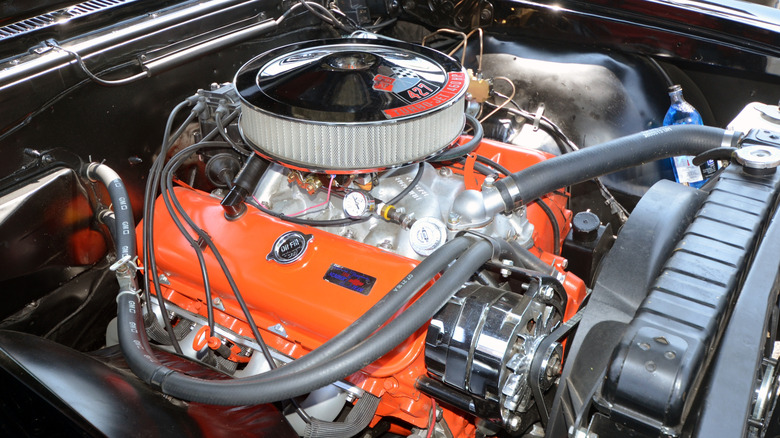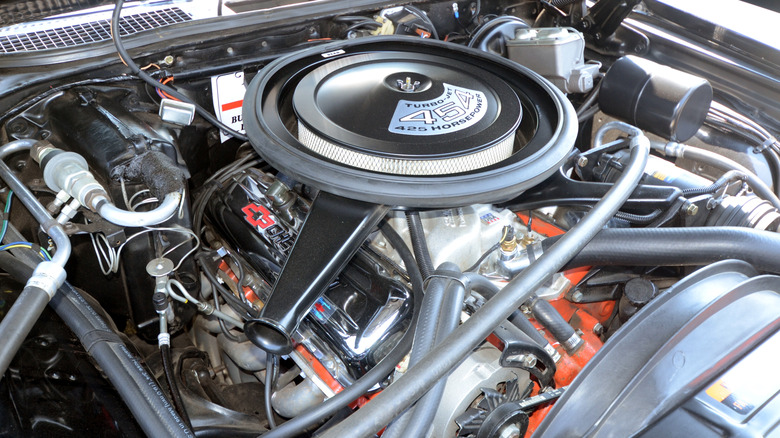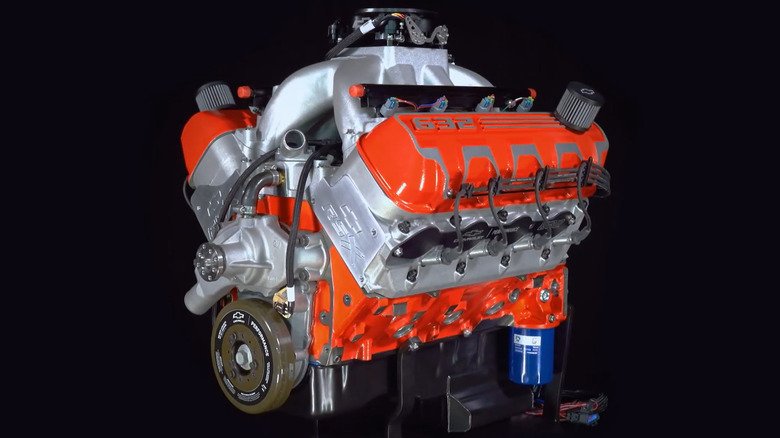Everything You Need To Know About Chevy's Big Block Engines
While there is some contention surrounding who produced the first muscle car, we can all agree that Chevrolet was certainly in the mix of it all during America's earliest muscle car days. In an effort to turn up the heat during the late 1950s, Chevy developed its first big block in '58, the W-Series. The first of these was the 348, also dubbed the "Special Turbo Thrust," and it packed up to 350 horsepower depending on the application. Following this came the 409, which quickly soared in popularity, thanks in part to the Beach Boys' hit song "409," but due to the impressive performance it kicked out on drag strips up and down the country.
From here, the Chevrolet big block story explodes, with the golden era of muscle cars kicking off right as Chevy begins to really dive in headfirst and explore the true power potential of big block V8s. The soaring popularity of Corvette and Camaro models saw power outputs and engine capacities seemingly growing year-on-year, fueled by a hunger for victories on the track. These were well and truly the "win on Sunday, sell on Monday" days, and so Chevrolet's big block family grew exponentially, resulting in a performance lineage that now stretches across six decades.
The early days of Chevrolet big block engines
After the W-Series 348 and 409 had been introduced, Chevrolet turned up the heat with the Mark IV engine family. This new generation of big blocks was lighter, more powerful, and more diverse. The 396, 427, and 454 were mainstays, and each was more potent than the last. The 1969 ZL1 427, which sported an engine made almost entirely of aluminum and packed with cutting-edge features, became the stuff of legend; barely street legal and ferociously fast, ZL1-equipped Camaros are now insanely collectible and equally expensive.
The 454 was arguably Chevrolet's most iconic big block lump of the era. With torque figures exceeding 500 lb-ft and power output reaching the dizzying heights of 450 horsepower, it became the big block to beat. Chevy was sure to equip both Corvettes and Chevelles with this mean motor, and the brand's line-up had never been quicker.
As tightening emissions regulations and a hunger for improved running costs from the American people signaled the end of the golden era of muscle cars, Chevrolet adapted. The 454-CI L19 brought electronic fuel injection to big blocks in 1987, boosting efficiency without sacrificing V8 power for Chevy trucks, such as the 454 SS muscle truck. In 1991, Gen V big blocks introduced modern upgrades, such as non-adjustable valvetrains and cast aluminum valve covers.
Chevrolet's big blocks in the modern era
In the final years of Chevrolet's production big-block engines, Chevy introduced Gen VI engines, which included the final production big block, the 8.1-liter Vortec. This V8 marked the end of an era when it arrived in 2001. Rather than powering muscle cars like the older generations of Chevy big blocks, these Vortec lumps could be found under a variety of trucks from the GM range, and even more unusual models, such as motor homes.
Big-block engines might not feature in Chevrolet's production models anymore, but that doesn't mean they are completely absent. In 2021, Chevrolet stunned gearheads with its biggest and most powerful crate engine ever built: the ZZ632. This 632 cubic-inch, or 10.35-liter, monster delivers an insane 1,004 horsepower and 876 lb-ft of torque. What makes this all the more impressive is that the ZZ632 manages this with no supercharger and no turbo – it's the pinnacle of naturally aspirated V8 tech. That's not the only big-block currently on offer, either, as Chevrolet offers a wide range of big-block crate engines at the moment. Options include the 427, 454, 502, 572, and aforementioned 632.


